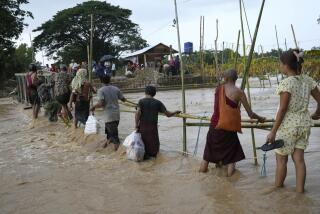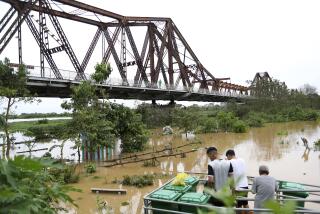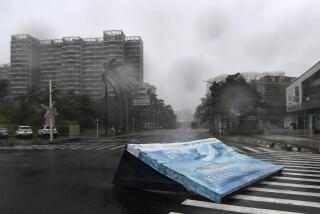Mighty Mekong Inundates Vietnam, Cambodia
- Share via
HANOI — The mighty Mekong River flooded a wide swath of Southeast Asia on Thursday, inundating villages and homes in Vietnam’s rice bowl and leading to warnings that streets in the Cambodian capital could be under water by the weekend.
With the river rising half an inch a day for the past month in some areas--and not expected to peak until next week--more than half a million people have been left homeless, schools closed, roads cut and at least 97 people killed.
Meteorologists said flood waters may reach the highest levels in the region in 75 years.
In Phnom Penh, the Cambodian capital, the government began distributing 350,000 sandbags as the world’s seventh-longest river--about 2,700 miles from China to the South China Sea--washed across the nearby low-lying plains, lapping its way toward the city of about 1 million people.
The water level near Phnom Penh is expected to reach 37 feet today. Officials said streets in the city could be flooded if the level reaches 38 feet, the Associated Press reported.
Cambodian Premier Hun Sen toured an area near the capital and told reporters: “I have participated to stop the killing fields, the genocide of Pol Pot . . . but it is impossible for me to stop the natural disaster.”
The International Committee of the Red Cross issued an appeal for assistance to the region, saying that about 600,000 people had lost their homes and farms.
Although more than half of Vietnam’s food is grown in the Mekong River basin, agricultural officials said the flood’s impact on rice production there will be minimal because most of the crop has been harvested. Vietnam is the world’s second-largest rice exporter.
Unlike the typhoon-spawned flash floods that struck Vietnam’s central coast in November, killing 730 people, this year has seen a gradual day-by-day buildup of the Mekong in Vietnam’s Long An, Dong Thap and An Giang provinces along the Cambodian border.
The Mekong is not controlled by sophisticated dikes in that region, as rivers have been for centuries in northern Vietnam. Residents have learned to live with annual flooding because, as with Egypt before the damming of the Nile, it is a natural occurrence that gives the soil its fertility and farmers their income.
“You can predict floods in the Mekong basin, and you can warn people,” said Marshall Silver, a technical advisor with the United Nations Development Program in Hanoi, “but there’s not a lot else you can do. It’s a low-lying area, resembling the Mississippi River delta in the United States in many ways, and there’s no higher ground for people to move to.”
Vietnamese First Deputy Prime Minister Nguyen Tan Dung, who toured the area Wednesday and announced a $2-million assistance grant, found farmers camped out under Red Cross plastic sheeting, many homes submerged, and a growing shortage of drinking water, food and mosquito nets. Many residents were traveling between villages in boats.
“The rain generally hasn’t been any more serious this year than in other seasons,” Silver said, “but with the environmental degradation of the Mekong basin, the floods come faster and rise higher. The forests that used to retard the runoff in the rainy season are no longer there.”
Many of the region’s lush mangrove swamps were destroyed by U.S. chemicals, such as Agent Orange, during the Vietnam War in an attempt to deny the Viet Cong guerrillas access to shelter and camouflage. And thousands of forested acres have been leveled in Vietnam, Cambodia and Laos by illegal logging operations and by farmers clearing land or seeking sources of charcoal.
In Vietnam alone, forest cover has been reduced from 45% to 15% of the land since the war ended in 1975, with logging and land clearance consuming trees at a rate of about 2 square miles a day.
Vietnam is known as one of Southeast Asia’s most disaster-prone countries. It has been struck by 212 typhoons since 1954--sometimes by as many as 10 a year--and frequently is ravaged by floods and landslides.
The U.N. Development Program’s disaster management unit says natural disasters have killed more than 13,000 people in Vietnam in the past three decades, including 2,123 still listed as missing after Typhoon Linda hit in 1997.
More to Read
Sign up for Essential California
The most important California stories and recommendations in your inbox every morning.
You may occasionally receive promotional content from the Los Angeles Times.













